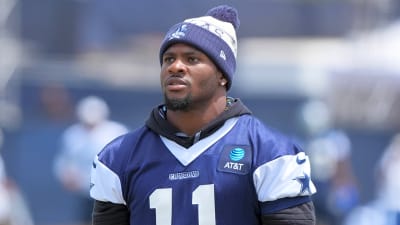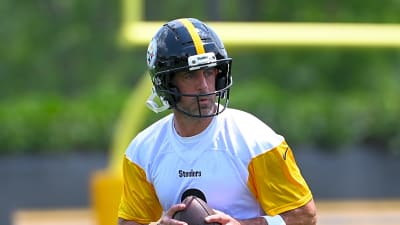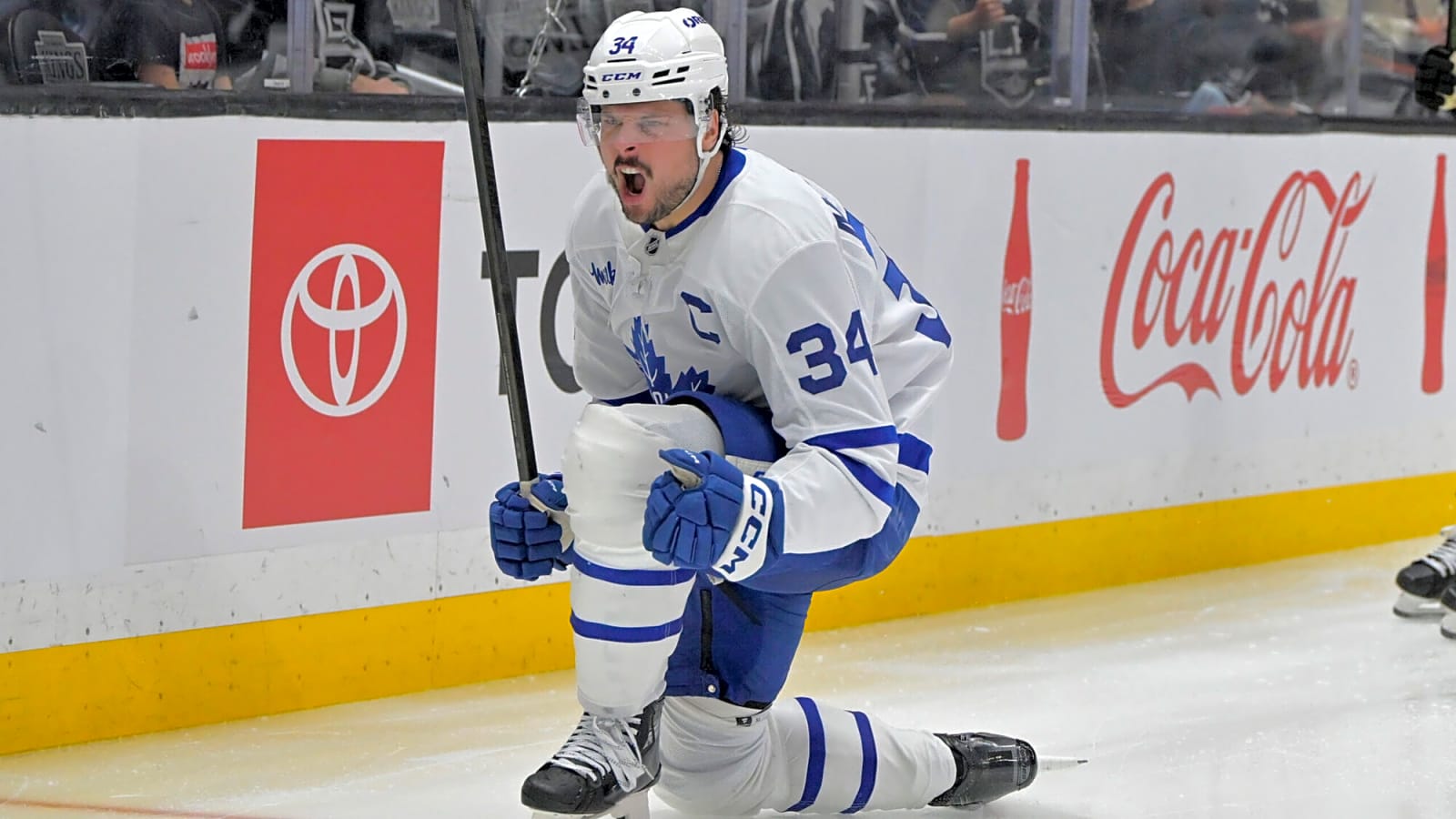
The fun thing about worrying about who is going to pass the puck to Auston Matthews is that no matter who you suggest, the answer is going to be an underwhelming option to Mitch Marner. The suggestions of Max Domi, Matias Maccelli, or even William Nylander all come with a drawback, and with limited cap space and limited potential trade partners, any answer given will be scrutinized.
Over the past three seasons, Mitch Marner has assisted on 50% of Auston Matthews’ goals, that number drops to 44% when only looking at even strength non-empty net goals). That doesn’t seem like a completely irreplaceable number. And in context, Matthews was less dependent on Marner for assisting on his goals than Leon Draisaitl was on Connor McDavid by 6%.
Assists on Matthews goals in all situations 2022-23 to 2024-25:
| All Situations (142) | Primary | Secondary | Total Assists | % of Goals |
| Mitch Marner | 44 | 27 | 71 | 50.0% |
| William Nylander | 26 | 12 | 38 | 26.8% |
| John Tavares | 8 | 10 | 18 | 12.7% |
| Matthew Knies | 10 | 7 | 17 | 12.0% |
| Morgan Rielly | 5 | 12 | 17 | 12.0% |
| Michael Bunting | 8 | 3 | 11 | 7.7% |
| T.J. Brodie | 2 | 5 | 7 | 4.9% |
| Jake McCabe | 2 | 3 | 5 | 3.5% |
| Max Domi | 5 | 0 | 5 | 3.5% |
| Oliver Ekman-Larsson | 1 | 4 | 5 | 3.5% |
| Pontus Holmberg | 3 | 2 | 5 | 3.5% |
| Rasmus Sandin | 1 | 4 | 5 | 3.5% |
| Timothy Liljegren | 3 | 2 | 5 | 3.5% |
| Mark Giordano | 3 | 1 | 4 | 2.8% |
| Tyler Bertuzzi | 1 | 2 | 3 | 2.1% |
| Bobby McMann | 0 | 2 | 2 | 1.4% |
| Conor Timmins | 2 | 0 | 2 | 1.4% |
| Ilya Lyubushkin | 1 | 1 | 2 | 1.4% |
| Justin Holl | 1 | 1 | 2 | 1.4% |
| Mac Hollowell | 1 | 1 | 2 | 1.4% |
| Noah Gregor | 1 | 1 | 2 | 1.4% |
| Alexander Kerfoot | 1 | 0 | 1 | 0.7% |
| Calle Järnkrok | 1 | 0 | 1 | 0.7% |
| Chris Tanev | 1 | 0 | 1 | 0.7% |
| John Klingberg | 0 | 1 | 1 | 0.7% |
| Nicholas Robertson | 0 | 1 | 1 | 0.7% |
| William Lagesson | 0 | 1 | 1 | 0.7% |
Matthews had 11 unassisted goals over this time span.
Assists on Matthews goals at even strength from 2022-23 to 2024-25:
| Even Strength (91 goals) | Primary | Secondary | Total Assists | % of goals |
| Mitch Marner | 28 | 12 | 40 | 44.0% |
| William Nylander | 14 | 3 | 17 | 18.7% |
| Matthew Knies | 7 | 6 | 13 | 14.3% |
| Michael Bunting | 7 | 3 | 10 | 11.0% |
| Morgan Rielly | 3 | 7 | 10 | 11.0% |
| T.J. Brodie | 2 | 5 | 7 | 7.7% |
| John Tavares | 1 | 4 | 5 | 5.5% |
| Max Domi | 5 | 0 | 5 | 5.5% |
| Oliver Ekman-Larsson | 1 | 4 | 5 | 5.5% |
| Pontus Holmberg | 3 | 2 | 5 | 5.5% |
| Jake McCabe | 1 | 3 | 4 | 4.4% |
| Mark Giordano | 3 | 1 | 4 | 4.4% |
| Timothy Liljegren | 2 | 2 | 4 | 4.4% |
| Rasmus Sandin | 0 | 3 | 3 | 3.3% |
| Tyler Bertuzzi | 1 | 2 | 3 | 3.3% |
| Conor Timmins | 2 | 0 | 2 | 2.2% |
| Ilya Lyubushkin | 1 | 1 | 2 | 2.2% |
| Justin Holl | 1 | 1 | 2 | 2.2% |
| Mac Hollowell | 1 | 1 | 2 | 2.2% |
| Noah Gregor | 1 | 1 | 2 | 2.2% |
| Alexander Kerfoot | 1 | 0 | 1 | 1.1% |
| Bobby McMann | 0 | 1 | 1 | 1.1% |
| Calle Järnkrok | 1 | 0 | 1 | 1.1% |
| Nicholas Robertson | 0 | 1 | 1 | 1.1% |
| William Lagesson | 0 | 1 | 1 | 1.1% |
That’s a pretty substantial drop-off from Marner to the rest of the Leafs so here’s a bit of context when it comes to playing time and here are the skaters that have been on the ice with Auston Matthews for at least 5% of his even strength ice time over the past three seasons:
| TOI With | % of Austons ES icetime | |
| Mitchell Marner | 2246.22 | 61.5% |
| Morgan Rielly | 1378.30 | 37.7% |
| Matthew Knies | 1332.20 | 36.5% |
| William Nylander | 1076.25 | 29.5% |
| Jake McCabe | 861.57 | 23.6% |
| TJ Brodie | 856.93 | 23.5% |
| Michael Bunting | 757.80 | 20.7% |
| Timothy Liljegren | 605.37 | 16.6% |
| Mark Giordano | 500.80 | 13.7% |
| Simon Benoit | 500.50 | 13.7% |
| Oliver Ekman-Larsson | 402.62 | 11.0% |
| Chris Tanev | 387.28 | 10.6% |
| Justin Holl | 361.50 | 9.9% |
| Tyler Bertuzzi | 346.88 | 9.5% |
| Calle Jarnkrok | 310.07 | 8.5% |
| Conor Timmins | 306.75 | 8.4% |
| Max Domi | 277.70 | 7.6% |
| Rasmus Sandin | 230.38 | 6.3% |
| John Tavares | 224.75 | 6.2% |
The context around ice time starts showing where players like Nylander, Domi, and Tavares have some capacity to fill the gap. And someone like Matias Maccelli certainly seems capable of emulating what Domi does as well, but arguably when it comes to consistent talent level and potential style fit, William Nylander seems like the best choice but comes at the expense of the Leafs being top heavy on their offensive production, though the Leafs would likely take the trade off of a drop off in John Tavares’ even strength goal production for the chance to maintain Auston Matthews’.
When looking at the Leafs moving on from Marner you can find optimism in how Alex Ovechkin was able to keep on trucking after Nicklas Backstrom had his career derailed by injuries. Neither Evgeny Kuznetsov nor Dylan Strome fully replaced Backstrom but have had serviceable runs alongside Ovechkin, and that’s what the Leafs need to shoot for with moving on from Marner. William Nylander is more than capable of being the Kuznetsov type replacement, while the Leafs continue to look for Strome or Pierre-Luc Dubois type options that round out their top six and could potentially present better fits.
Not all players are necessarily going to respond the same way and you can point to the drop off in production seen in Steven Stamkos after Martin St. Louis retired until Nikita Kucherov and Brayden Point emerged as replacements as a potential parallel to a goal scorer that needed elite partners in crime.
There is also something to be said for the Oates vs. Janney effect.
Adam Oates was Brett Hull’s setup man for two seasons before getting dealt in the third, and the Hull and Oates combo was responsible for Hull’s 72 goal, 86 goal, and 70 goal campaigns. After Oates’ departure, Hull’s best season was 57 goals, which doesn’t sound like an ideal outcome and obvious step back, but Hull remained a top ten goal scorer in the league for the next three seasons, and his significant numbers decline coincided with his mid 30s, when a production drop off seems reasonable.
Oates would go on to have an absolutely bonkers 92-93 season with 97 assists, where he set up no one player in particular, but then played a big role in Cam Neely’s 50 goal in 49 game campaign. The Oates and Neely combo was huge and Neely had 11 goals in 13 games in the previous season as well as nine in nine in 1991-92, but not all of his success should be hung on playing with Oates as he had two 50+ goals to his name immediately preceding Oates’ arrival in Boston.
The interesting part of the pre-Oates Neely results in Boston and the post-Oates Hull production in that Craig Janney was the centre Neely had before and Hull had after. The Oates for Janney (and Stephane Quintal) trade shows the impact of having a premiere playmaker vs. a very good playmaker on an elite goal scorer. I’m not sure how many scoring takeaways from the 80s/early-90s NHL are universal, but Leafs adjusting expectations to Matthews as targeted for 40 goals rather than trying to count on him for 50 might be a lesson to be learned here, as well as it would be bold to consider options like Maccelli or Domi to be Craig Janney level. If we’re making this comparison Nylander would likely be the closest in-house option the Leafs have to a Craig Janney level playmaker but with the added bonus of being a legitimate goal scorer in his own right.
What is also interesting is that while last season was Marner’s most dominant offensive year, finally eclipsing 100 points and setting a career best of 75 assists, it was not Matthews’ best goal scoring season. It did see more frequent Marner assists on Matthews goals (20x or 60%) which is really more of a tale of Matthews’ drop in production than it is either player particularly relying on the other more or less last season.
Matthews goals by season since 2022-23:
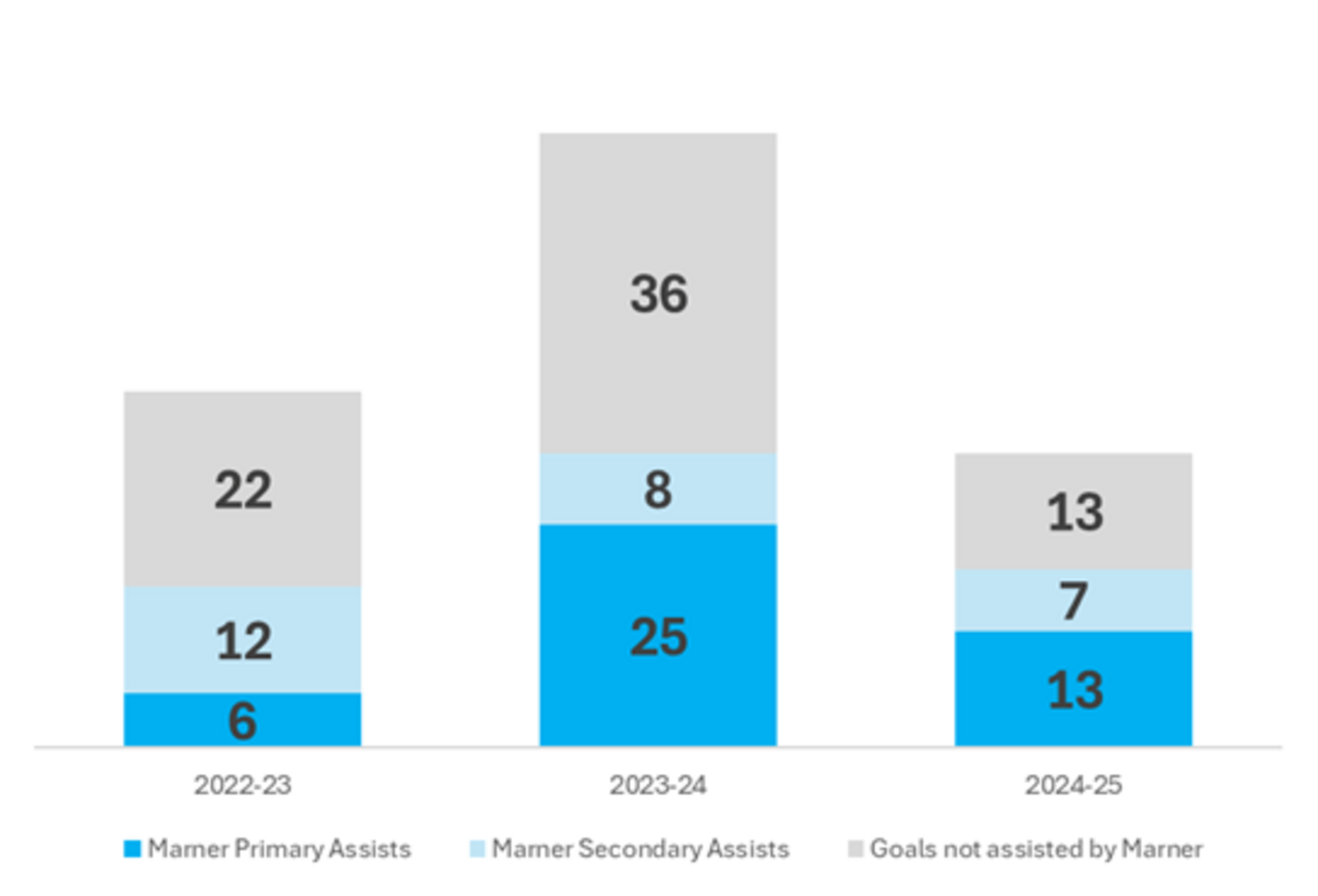
If there is an encouraging takeaway it is that Marner being in on over 50% of Matthews’ goals is a new occurrence and while he’s certainly played a big role it is also due to the time they spend playing together.
When it came to ice time with Matthews in 2022-23 Michael Bunting was the most frequent linemate for Matthews with time fairly evenly split between Marner and Nylander on the other side, other than that the last time Nylander came close to Marner in time on ice with Matthews was in 2019-20. Nylander with Matthews might not be rare, but Mitch Marner has been a staple for him throughout the Keefe years and last season under Berube. Even if Nylander is the direction the Leafs go in this is far from business as usual.
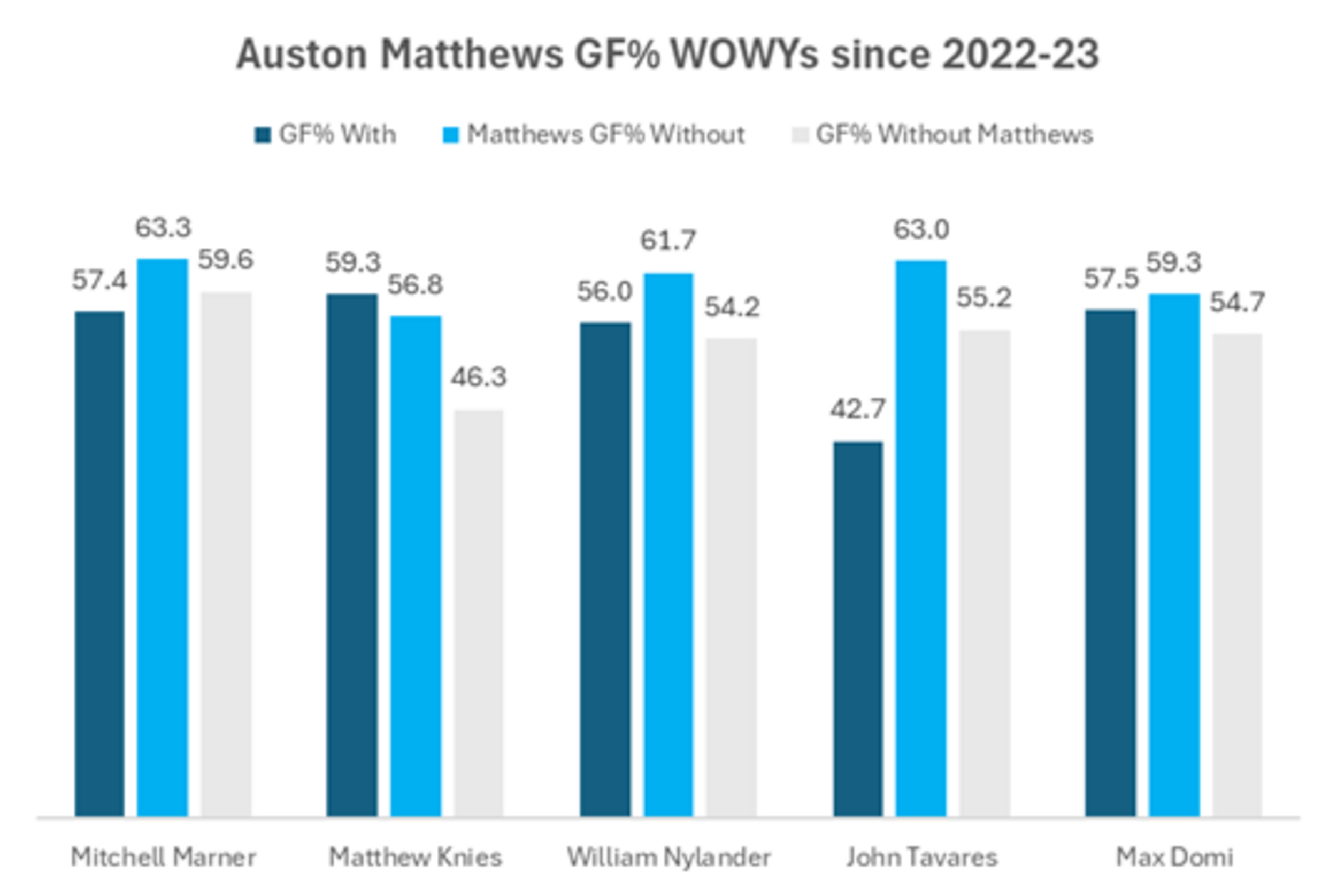
From the little bit of information that can be gleaned from on ice goals for, it seems like Matthew Knies has been the most impactful linemate for Matthews as his goals for differential (or +/- if you will) was not only highest with Knies but Knies is the only forward that was regularly playing with Auston that Matthews did worse with when playing away from them with the exception of Michael Bunting.
Both Nylander and Domi closely mirror the results of Marner when it comes to their time on ice with Matthews at even strength and in theory could leave Toronto no worse for wear without Marner.
Some additional context to those numbers are that both Tavares and Domi have played less than 300 minutes with Matthews at even strength in the past three years and both Domi and Tavares have been decimated by PDO in those outings (Tavares .783 PDO with a 62.86% on ice save percentage.) There is a lot to be said for Marner’s defensive play as well that isn’t covered in this post but shouldn’t be excluded as it will impact the way Matthews is forced to play at even strength.
The takeaway should be that the Leafs aren’t cooked and if the plan was for the Leafs to be different than the “Core Four” Shanahan era, this is definitely heading in that direction. Marner absolutely contributed to the Matthews line and there are a lot of elements of his game that will be missed, including playmaking, but William Nylander seems like a capable option to step into that role if the drop off from Marner to Domi or Maccelli is too much to put on Matthews.
The Leafs taking a bit of a wait and see approach also lets Brad Treliving and Craig Berube assess whether a good but not great playmaker is the priority over other needs or other areas of potential improvement for the Leafs. If you operate under the notion of Nylander replacing Marner on the top line, Maccelli looks like a capable option to put alongside Tavares. All the while the Leafs still have the ability to explore what to do with their remaining cap space and improve the roster.
When discussing Matthews and Marner the quality of playoff performances always needs to be considered as well. With Marner as Matthews’ almost constant linemate in the playoffs, Matthews’ numbers would equate to a 31 goal, 40 assist, 82 game season. Marner drops to 15 goal, 59 assist performance in regular season context. So as much as it has been working in the regular season and as much as the two them are in on each other’s post season offence, they aren’t producing enough of it.
More than the absence of Mitch Marner, the Leafs main concern should be overall status of Auston Matthews. Presumably injuries played a big part in Auston’s drop off in 2024-25 (15 missed games supports that), and while no one should have reasonably expected Matthews to push the 70-goal barrier forever, a 33-goal follow up (although a 40-goal over 82 game pace) is a concern. With Marner or without, Matthews will need to be expected to improve on scoring results that were on par with the pace of his rookie season and lowest overall goal scoring outputs of his career. Finding him some help might be nice, but he also needs to do it on his own.
Data from Hockey Reference and Natural Stat Trick
More must-reads:
- NHL players who will send their GM a 'thank you' card next summer
- Could tire-kicking Cubs add a former AL Cy Young?
- The 'National League MVPs' quiz
Breaking News
Trending News
Customize Your Newsletter
 +
+
Get the latest news and rumors, customized to your favorite sports and teams. Emailed daily. Always free!

